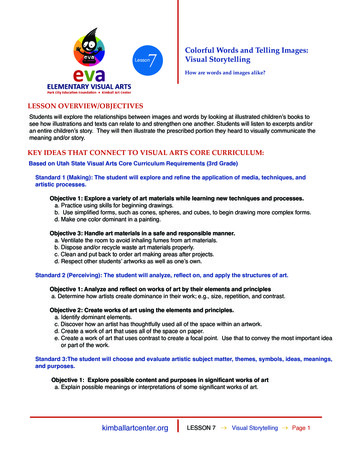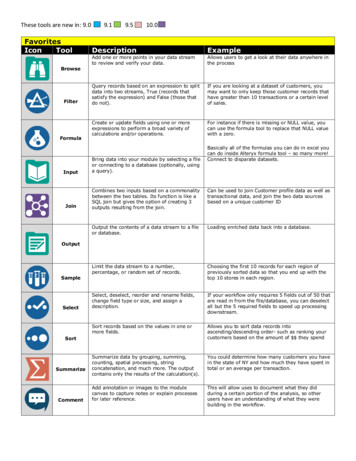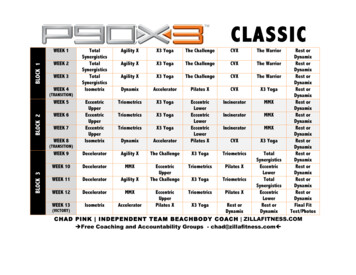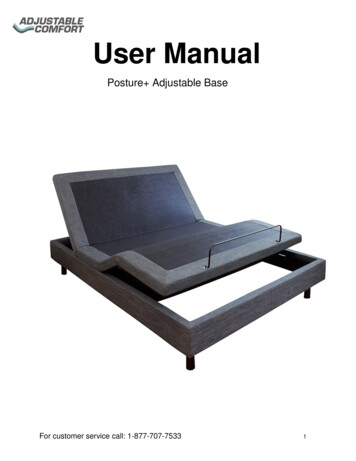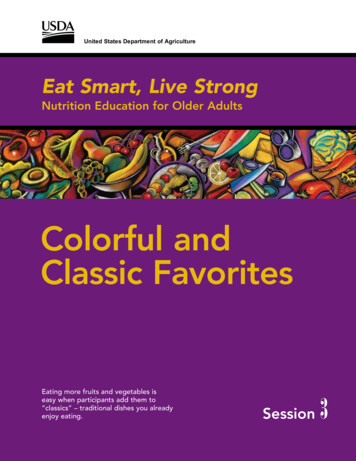
Transcription
United States Department of AgricultureEat Smart, Live StrongNutrition Education for Older AdultsColorful andClassic FavoritesEating more fruits and vegetables iseasy when participants add them to“classics” – traditional dishes you alreadyenjoy eating.Session3
3Welcome!SessionWelcome to Eat Smart, Live Strong. This is one of four fun, social, andinteractive sessions. The Eat Smart, Live Strong sessions are designed tohelp older adults adopt two behaviors that may improve their healthand overall well-being. The two behaviors are:1 Eat at least 31/2 cups of fruits and vegetables every day(11/2 cups of fruit and 2 cups of vegetables)2 Participate in at least 30 minutes of moderate-intensity physicalactivity most daysEach session includes a handout thatdescribes four physical activity exercises.With an extra 10 minutes before and aftereach session, you may lead participants inthese exercises as a “warm-up” and/or a“cool-down.”The four sessions in this kit are:1 Reach Your Goals, Step by StepSession 2 Challenges and SolutionsSession 3 Colorful and Classic FavoritesSession 4 Eat Smart, Spend LessSessionEach session is designed to address specificways to help participants adopt the behaviors.To learn more about the behaviors, pleasesee the Eat Smart, Live Strong Leader’sGuide.You can use the session guides “as is” ortailor them to meet your group’s needs.Refer to the Leader’s Guide for tips onadjusting the session to meet the needs ofyour audience. The sessions are designedto flow together, each session furtherreinforcing the key behavioral messages.However, you can use the sessions asstand-alone pieces if you do not have theopportunity to provide all four.Enjoy!The sessions are meant to be fun for you – the group leader – and for the participants.
Session3Colorful and Classic FavoritesObjectives for Session 3Participants will be able to:nName at least three traditional dishesthat are more nutritious with an addedfruit or vegetable.nTaste a traditional dish with an addedfruit or vegetable.Session OverviewnnIf conditions allow, participants mayhelp to prepare the dish they willsample. Participants briefly talk about a recipethey would like to try in the nextweek and ways they will continue toincrease their physical activity. Each participant takes homesuggestions for enhancing “classic”dishes and the set of recipe cards.Participants have a chance to practicefour simple exercises in an optional10-minute physical activity “warm-up.”In the session: The group reviews the two behaviorsand their benefits. Participants report on progresstoward their goals. Using colorful photos of “classicfavorites” – dishes they already knowand like – participants suggest a fruitor vegetable to add to the classic dish. The leader passes out recipe cardsand lets participants taste a classicdish with an added vegetable.nParticipants repeat the same four simpleexercises in an optional 10-minutephysical activity “cool-down.” Theyreceive a handout that visually depictsthe exercises so they can do them at home.How the Session Encourages BehaviornnnAwareness: Participants may never have thought of adding a fruit or a vegetable to aclassic dish. Just the idea may inspire them to try it.Skills and self-confidence: Participants hear and experience how easy it is to add fruitsand vegetables to their daily diets without giving up their favorite foods.Try it and like it: If you are able to prepare an “enhanced” dish for them to taste,participants may find they like it and be motivated to try it at home.Session 3: Colorful and Classic Favorites1
Session3Materialsn3SessioClassicsetabled Vegs.na.sitFru FavoriteAdd laablesicr VegetFruit oto C sPlusDishesnA place to write so all can see: large sheets of paper (flip chartpages), masking tape, and markers, or chalk board and chalk, or white board and erasable markersn10-20 blank index cards or pieces ofpapernResource 1: Make a Classic Bettercards, provided with Session 3 handouts. Traditional dishes Fruits VegetablesnPrepared classic dish that has avegetable added to it (see recipe cardsfor suggestions)nServing utensilsnEating utensils, paper plates, napkins,and cups – one set per participantnHandouts: Handout 3a: Set Your Goals Handout 3b: Session 3 Exercises Handout 3c: Add Fruits andVegetables to Classic Favorites Handout 3d: Recipe Cards Handout 3e: Participant FeedbackSheetsPeache YogurtRaisins lOatmeallasQuesadioesTomat ppersand Pe hSpinacaLasagn verTurn Oong, Live Strt Smartt 3c: EaHandou er 2012RevisedNovembSession3Recipe CardsCut on dotted lineOrange Pork ChopsInstructions:Ingredients:1. In a medium skillet, brown pork chops in a smallamount of oil. 2 pork chops1 sweet potato, peeled1/2 orange, sliceddash cinnamondash saltdash black pepperPreheat oven to 350 degrees F.2. Cut sweet potato into 1/2-inch slices.3. Place meat and sweet potato slices in a baking dishand top with orange slices; sprinkle with seasonings.4. Cover and bake for 1 hour until meat is tender.For safety, cook pork to 160 degrees F.Adapted from: Simply Seniors Cookbook, Utah State University ExtensionPineapple-Orange Frozen YogurtServing Size: 1/3 of recipeYield: 3 servingsCost: Per Recipe: 1.02Ingredients: 1 cup yogurt, nonfat vanilla 1/2 cup orange juice 1 cup pineapple chunks,fresh or cannedAdapted from: Food and Health Communications, IncHandout 3d:Revised November 20122 Serving Size: 1 chopYield: 2 servingsCost: Per Recipe: 1.89Eat Smart, Live StrongInstructions: 1. Place yogurt and fruit in large plastic bag, flattenand freeze overnight.2. Combine fruit, yogurt, and juice in food processoror blender and blend until smooth.3. Serve right away or place back in the freezer toharden until ready to serve, up to 1 hour, stirringoccasionally. Stir before serving.United States Department of Agriculture Food and Nutrition Service Eat Smart, Live Strong
SessionPreparationSession 33Set Your GoalsRecommended Goals1Eat at least 3 1/2 cups of fruits and vegetables every day.2Participate in at least 30 minutes of moderate-intensity physical activity most days.My Personal GoalsI will eat cup(s) of fruits and cup(s) of vegetables every day.I will get at least minutes of moderate-intensity physical activity on days next week.My Weekly LogIn the space provided, write the cups of fruits and vegetables you ate and the minutes of physical activity youcompleted each rday# of cup(s)# of cup(s)# of cup(s)# of cup(s)# of cup(s)# of cup(s)# of cup(s)# of cup(s)# of cup(s)# of cup(s)# of cup(s)# of cup(s)# of cup(s)# of cup(s)# of minutes# of minutes# of minutes# of minutes# of minutes# of minutes# of minutesCups offruitsCups ofvegetablesMinutes ofphysicalactivityHandout 3a: Eat Smart, Live StrongRevised November 2012 nChoose one of the recipes included inthe session to prepare in advance. Whenchoosing dishes to make for participantsto sample, consider: nTailor Handout 3a, Set Your Goals. Makea blank “master” photocopy. On thismaster, fill in the dates for the currentor upcoming week before you makecopies for participants. nMake copies of Handouts 3a, 3b, 3c, 3d,and 3e, one copy for each participant. nOrganize room so participants sit in asemicircle. If you do the physical activitysegments, use straight-back, firm chairsarranged in a semicircle at least 2 feetapart. Foods that are in season and/oraffordable on a limited budget Foods that your participants are likelyto eat Foods that are easy for you to serve inthe classroom or are easy to transport nObtain the needed paper/plastic goodsand utensils for serving everyone asample portion of the prepared dish.n3SesssioSession 3ExercisesThese exercises are designed to help you build strength,improve balance, and increase flexibility. In addition to atleast 30 minutes of moderate-intensity physical activity,include these exercises in your daily program.Session 32ExercisesLeg LiftsBegin your exercise session by taking 5 deep breaths –in through your nose and out through your mouth. Itis important to keep breathing deeply throughout theexercise session.1Stand Up and Sit Down Start in a seated position with arms crossed Stand up, trying not to use arms Sit down, trying not to use arms Repeat 10 timesHandout 3b: Eat Smart, Live StrongRevised November 2012 Sit in a chair Straighten right leg Lift leg as high as is comfortable Lower leg, keeping it extended and elevated Repeat 8 times Repeat with left leg* For additional challenge, use 1-pound ankleweightseetack SheedFabFtritesnvoaip rful and ClassicParsstioicloe groupn 3, Coeet to th .is sh e sessionfor Seturn ththform. Re improvelete thisr continue tos to compe leademomenthelp thts willabouttake a fewe leastPlease Your commenu like thleader.t did yo5. Wha sion?Date:this sesn youToday’sormatioinfthesuseful wasion?1. How from this seslearned e response.)l(Mark on t at all usefuout thisNo what usefulhear ab session?did yougSome l6. How art, Live StronUsefu usefulEat Sm that apply.)tritionVery(Mark all pplemental Nu officeramSuce Prognot?ytanwhsisAsWhy ordienFrr centerSenio rPosteerFly letterfruitst morewseaNeiptoingof worshek?u plannPlace r – specify2. Are yo getables next weand ve e response.)Othe(Mark on scipate?you partiYedosramich progNo not sure7. In wh that apply.) NutritionI amur(Mark all Supplemental ramrease yoing to inc ek?talce Progu plannweAssistan ity Supplemen3. Are yo l activity nextodphysica e response.)CommProgramFood’ Market(Mark on sFarmersrYenioSe tion ProgramNo not sureNutrid mealsdelivereI amaboutHomeregate mealse mostCong bank or pantryu like tht did yoodhaFoW4.sion?this sesg!onStreart, LivEat Smating inThankHandout 3b: Eat Smart, Live Strongparticipyou forart,Eat Smout 3e:Handmber 2012ed NoveongLive StrRevisRevised November 2012Session 3: Colorful and Classic Favorites3
Session3Optional Physical Activity Warm-UpIn addition to talking about the value of physical activity, you havethe option of leading participants through several simple exercises atthe beginning and end of each session.n Add10 minutes for each optional“warm-up” and “cool-down” exercisesession; they feature the same set ofexercises and the same handout is usedfor both.n Handout3b has all of the instructionsneeded to lead Session 3 exercises.n Participantswill have a chance to trythe same movements twice.n Thisrepetition, along with the handout,will give participants the skills, selfconfidence, and tools to do theseexercises on their own at home.4n Mostgroup leaders will find theexercises simple to lead.n Youdo not need to be a skilled exerciseinstructor to lead these exercises, butyou may want to try them out aheadof time so you will be comfortabledemonstrating them.n Keepin mind that you do not have touse all of the exercises presented inthis session. You may want to tailor thephysical activities to meet the needsof each group.United States Department of Agriculture Food and Nutrition Service Eat Smart, Live Strong
Session3ExercisesStand Up and Sit DownLeg LiftsnExplain that these exercises can improvestrength, balance, and flexibility.nAssure participants that most will findthese four simple exercises easy todo and many will be familiar with theexercises.nnLet them know that if they do not feelcomfortable or have a physical conditionthat prevents them from doing any or allof the exercises, it is OKAY to sit themout; if they feel pain, discomfort, orfatigue while exercising, they should nothesitate to stop or take a break; and,if they need assistance, they should letyou know right away.Pass out Handout 3b, Session 3Exercises, and ask participants to takea look at it.Tip!Two-Arm RowArm RaisesnState the four exercises on the handout: Stand Up and Sit Down Leg Lifts Two-Arm Row Arm RaisesnLead Session 3 Exercises 1-4, usingHandout 3b and directing participantsto look at the pictures.nDemonstrate the exercises, make sureparticipants can see you, giving afew, simple verbal instructions. Haveparticipants follow along as you repeateach exercise.nCheck whether the group is doing eachexercise correctly and help those whoappear to need additional instruction.nBe sure to encourage and give positivefeedback to participants as they try theexercises.Adding WeightsSome groups or individual participants may be ready to take on more challengingphysical activity. Provide additional challenge by suggesting 1-pound hand weights.Session 3: Colorful and Classic Favorites5
Session3Colorful andClassic Favorites16Welcome and IntroductionsnI ntroduce the session. Let participants know that this is thethird of four sessions in the Eat Smart, Live Strong series andthat today’s session is “Colorful and Classic Favorites.”nAcknowledge familiar faces. Give a big hello to those whoattended earlier sessions and assure newcomers that they willfind it easy to join in even though this is their first session.nIntroduce yourself. Mention one of your favorite dishes. Askparticipants to introduce themselves by stating their names andanswering the question: “What’s one of your favorite dishes (orrecipes)?” List each dish mentioned on a flip chart or chalk boardfor all to see. You will use this list later in the session.United States Department of Agriculture Food and Nutrition Service Eat Smart, Live Strong
Session3n S eta warm and relaxed tone for the session. Let participants knowthat you hope to learn from their experiences and that they mayoffer comments or ask questions at any time.nState the purpose of today’s session. Participants will think aboutways to add fruits and vegetables to some of their favorite dishes.nShare the length of the session. Let people know that the sessionwill take about an hour and mention other helpful information suchas the location of the rest rooms, water fountains, or exit areas.Session 3: Colorful and Classic Favorites7
Session3Colorful and Classic FavoritesTwo Important Behaviorsand Their Benefits2nExplain that the Eat Smart, Live Strong program focuses ontwo important behaviors. These are two actions that healthexperts recommend to improve the health and well-being ofpeople of all ages:1 Eat at least 31/2 cups of fruits and vegetables every day12 Participate in at least 30 minutes of physical activitymost daysn11/2 cupsFruitsMention that the ideal amount of fruits and vegetables for anyperson depends on activity level, age, and gender. Point outthat older adults should eat at least 31/2 cups each day.1 Oneand a half cups should be fruit. Two cups should be vegetables. 2 cups 31/2 cups ofFruits and Vegetables1Vegetables1 Based on the segment of the target audience with the lowest caloric need – sedentary women (1,600 calories per day).For older adults who are more active, recommend 2 cups of fruits and 21/2 cups of vegetables (2,000 calories per day).8United States Department of Agriculture Food and Nutrition Service Eat Smart, Live Strong
Session3nAsk participants to name some of the benefits of eating 31/2cups of fruits and vegetables every day. Make sure thefollowing are mentioned: Get some of the vitamins, minerals, and fiber needed tomaintain good health Maintain regularity Help prevent or delay the effects of chronic conditions suchas diabetes, obesity, hypertension, and heart disease Add color, taste, and variety to the dietnAsk participants to list some of the ways they can be physicallyactive. Be sure to include: Walkingbriskly Mowing thelawn Aerobicsn Weight liftingJoggingDancingSwimming Stationary cycling Active walkingor running withgrandchildrenDiscuss the benefits of engaging in 30 minutes of physicalactivity most days. Mention the following: Help prevent or delay the effects of chronic disease Feel better Decrease mild stress, anxiety, and depression Build and maintain healthy bones, muscles, and joints Improve strength Increase balance and reduce the risk of falling Improve sleepSession 3: Colorful and Classic Favorites9
Session33Colorful and Classic FavoritesMeasuring Your GoalsnThose who participated in Session 1 or 2 set goals forthemselves for both behaviors. Some may have brought backthe Handout, Set Your Goals, on which they recorded their dailysuccess. Ask them to share with the group how they are doing.nInvite participants to share their successes. Ask participantsto describe what has made it easier for them to do the twobehaviors.nHave the group congratulate those who have made progresstoward their goals.nHand out copies of Handout 3a to those who wish to continuetracking their success.Session 3Set Your GoalsRecommended Goals1Eat at least 3 1/2 cups of fruits and vegetables every day.2Participate in at least 30 minutes of moderate-intensity physical activity most days.My Personal GoalsI will eat cup(s) of fruits and cup(s) of vegetables every day.I will get at least minutes of moderate-intensity physical activity on days next week.My Weekly LogIn the space provided, write the cups of fruits and vegetables you ate and the minutes of physical activity youcompleted each rday# of cup(s)# of cup(s)# of cup(s)# of cup(s)# of cup(s)# of cup(s)# of cup(s)# of cup(s)# of cup(s)# of cup(s)# of cup(s)# of cup(s)# of cup(s)# of cup(s)# of minutes# of minutes# of minutes# of minutes# of minutes# of minutes# of minutesCups offruitsCups ofvegetablesMinutes ofphysicalactivityHandout 3a: Eat Smart, Live StrongRevised November 201210United States Department of Agriculture Food and Nutrition Service Eat Smart, Live Strong
Session3Skills-Building Activity4Be sure that everyone is seated comfortably and that all can seeyou, the leader.Card Game: Make a Classic Bettern3SessioClassicame:tterCard Ga Classic BeMakengCut alonTell participants that today’s learning activity focuses on waysto enjoy their favorite dishes while eating more fruits andvegetables (Use Resource 1: Make A Classic Better cards.)nLay the fruit cards and the vegetable cards on a table or on thefloor where all can see them.nPoint out the list of favorite dishes mentioned during theparticipant introductions. Select a “classic dishes” card thatillustrates one of these. Hand the card to a participant whomentioned the dish. You might not have a card for each dishlisted. In this case, write the name of the dish on a blank card orsheet of paper. Hand out additional “classic dishes” cards untileach participant has one.nInvite a volunteer participant to kick off this activity by walkingto the front of the room with his or her “classic dishes” card. Askthe volunteer to state, “This is one of my favorite classic dishes.I invite (name of another participant) to help me make it morecolorful and tasty by adding a fruit or vegetable.”nThe named person picks up a fruit card or a vegetable card andstands next to the volunteer at the front of the room. Ask her tostate, “I’ll make this dish more colorful and tasty by adding(name of selected fruit or vegetable).” Let participants know thatthey can choose a fruit or vegetable as an added ingredient tothe recipe or as a side hole Whech on WSandwiTurkeySession 3Card Game:Make a Classichetti Betterss SpagTunaMeatleClassic DishesEatrce 1:r 2012ResouNovembePotatoBreadCut along perforationsSmart,ongLive StrRevisedMacaroni and CheeseChicken SoupHamburgerChiliEgg on ToastQuesadillas with CheeseResource 1: Eat Smart, Live StrongRevised November 2012Session 3: Colorful and Classic Favorites11
Session3Colorful and Classic FavoritesSkills-Building Activity4Card GameSession3erame:Card Ga Classic BettMakengCut aloionsperforatOrangeAsk participants to talk about the new colorful and classic favorite.You may ask: Have any of you ever added this fruit (or vegetable) to this dish? How do you think this would taste? How hard would it be to add the fruit (or vegetable)? How much fruit (or vegetable) – in cups – might this classicdish add to your daily diet? What other fruits (or vegetables) would be good in this dish? Would you try this at home?nThese two participants take their seats. Ask a second volunteerto walk to the front of the room and display her “classic dishes”card. She calls upon another participant to pick a fruit orvegetable to add to the dish. Discuss the choices.nLook for opportunities to talk about the importance of eatinga variety of colors of fruits and vegetables. Adding fruits orvegetables to a classic dish is just another chance to vary thecolors you eat. By eating a colorful variety of fruits andvegetables every day, you ensure that you have the wide rangeof vitamins and minerals your body needs to maintain goodhealth and energy levels.nRepeat until everyone has had a chance to present a classic Fruit CoRevisedNoveongLive StrSmart,Card Game:Make a Classic Betterce 1: EatSessionResour3mber 2012FruitsCut along oGrapesResource 1: Eat Smart, Live StrongRevised November 2012Tip!continuednFruitsSlicedcontinuedKeep Moving!Help participants stay physically active during the learning activity. Asking participantsto move to the front of the room to play the game gets them out of their chairs.Make sure that no one feels left out because of physical limitations. You or anotherparticipant may help people join in even if they have trouble standing, walking,grasping, hearing, or seeing.12United States Department of Agriculture Food and Nutrition Service Eat Smart, Live Strong
SessionSessio3Cardame:Make Ga Classic Bettlesern3VegetabCut alongSlicedperforationsCucumberCarrotsSaladTaste a Colorful ClassicnInvite participants to taste the classic recipe you have prepared,a traditional dish with an added vegetable. Depending on timeand room layout, you may allow people to walk to the table andserve themselves, or you may hand out portions as participantsremain seated.nAsk participants to describe what they are tasting. How do theylike the taste or the texture? How could the enhanced dishadd to the variety of colors they are eating? Would they try toprepare this dish themselves? What elsecould they add?nLet participants know how many cups offruits or vegetables should be in eachportion of the dish.nRemind participants that they should aimto eat a variety of colors of fruits andvegetables.GreenPepperNavy BeansResourcRevisede 1: Eat Smarter 2012,NovembSlicedLive StrongSession 3EggplantCard Game:Make a Classic BetterVegetablesCut along perforationsTomatoesSpinachCornGreen BeansPeasBroccoliResource 1: Eat Smart, Live StrongRevised November 2012Tip!Let Them Cook!Older adults may have years of experience in the kitchen. If you have the time and anappropriate setting, participants would enjoy helping you prepare a classic favorite.Follow one of the recipes in the handouts or choose one that you know is successfulwith the group. Depending on the dish selected, you may need to: Select and purchase ingredients that are low-cost – or available through a fooddistribution site or a Senior Farmers’ Market. Wash or prep the ingredients ahead of time. Provide utensils and plates or bowls. Use measuring cups to show how much fruit or vegetable is added.Session 3: Colorful and Classic Favorites13
3SessionSkills-Building Activity4Session3ClassicColorful and Classic FavoritesHandouts: Taking the Ideas HomeblesVegetaits anvdorites.ruFddableA lassic FVegetaFruit orto CPlusDishesnGive everyone Handout 3c, Add Fruits and Vegetables to ClassicFavorites.nPoint out that the pictures on one side show ways to add fruitsand vegetables to some traditional favorite dishes. The reverseside has information to share with family members, friends, orcaregivers.nPass out copies of the recipe cards (Handout 3d). Haveparticipants discuss these ideas.nAsk a few questions to help participants commit to tryingsomething new: We talked about several ways to add fruits or vegetables to yourfavorite dishes. Which combinations do you think you would liketo try? Do you have any more combination ideas you would like toshare before we end today’s session?nOffer copies of Handout 3a, Set Your Goals, to those who want them.sPeache YogurtRaisins lOatmeaoesTomat ppersand Pe llasQuesadihSpinac aLasagnerTurn Ovart,Eat Smt 3c:2012HaneddouNovemberngLive StroRevis514continuedWrap-UpnSummarize the main point of the session: “A great way toincrease the amount of fruits and vegetables you eat is to addthem to your favorite classic dishes.”nAsk how they plan to be physically active during the upcomingweek.nThank participants for joining this session and invite them to thenext session, letting them know the time and place.United States Department of Agriculture Food and Nutrition Service Eat Smart, Live Strong
Session3nRemind participants to bring their filled-in Set Your Goals weeklylogs to the next session so they can report on their progress.nLet participants know that their honest feedback about today’ssession will help you to improve the session for future groups.Using the Participant Feedback Sheet (Handout 3e) and/orthrough discussion, ask some of these questions: What new thing did you learn? Which part of the session was most important to you? Do you think goal setting will help you eat at least 31/2 cupsSesssioof fruits and vegetables every day? Will your goals help you to participate in at least 30 minutesof physical activity most days of the week? How could we make the session better? How did you hear about today’s session? – or – How did youhear about the Eat Smart, Live Strong program?Participant FeedbackSheetcommen nts to con3for Session 3, Colorful and ClassicPleaseFavoritleader. take a few moesYourmempts willToday’shelp th lete this forDate:m.e leader continuReturn thissheet toe to im1. Howprove ththe grouuseful wae sessionps the inflearned.ormatiofrom thin you(Mark ons session?e respo5.What didnse.)Notyouat all uslike thethis sesSomeefulleast absion?whoutUsefu at usefulVery lusefulWhy orwhy not?6. HowdidEat Smar you hear about(Mark all t, Live Strong ses thission?thatSupp apply.)lem2. Are you plaAssistan ental Nutritioand vege nning to eatFrien ce Program nmotaboffice(Mark on les next week re fruitsSenio d?e resYes ponse.)Poste r centerNoFly rerI amNewsnot sureletPlace ter3. Are yoof worshOtu planniping to incphysicaher – specifyl acrea(Mark on tivity next we se yourek?e res7. In whYes ponse.)ich(Mark all programs doNoyou partithat apcipate?I amSupp ply.)not surelementalNuAssistantritio4. What didComm ce Program nodity Suthis ses you like themost absion?ppFolementalodoutSenio Programr Farmers’ MarkNutriHometion Program etCong delivered mealsFood regate mealsThankbank oryou forpantryparticipatiHandoutRevised3e: EatSmart,r 2012NovembeLive Strongng in Eat Smart,nIf you are using the written Participant Feedback Sheets, assureparticipants that this is not a test – and that there are no wronganswers! Encourage honest opinions. Help people who havedifficulty writing. Collect the feedback sheets. You will findit useful to review participants’ responses. Tabulating theiranswers can help you find ways to improve the session beforeyour next group. The feedback also may help you report onyour educational activities.Live Strong!Session 3: Colorful and Classic Favorites15
Session3Optional Physical Activity Cool-DownFollowing the session, add 10 minutes to lead the same set ofexercises with which you opened this session. If you opted not to dothe “Warm-Up,” refer to pages 4-5 for more explanation.nAnnounce that the last activity inthe session will be 10 minutes of“cool-down” exercises.nEmphasize that if they do not feelcomfortable or have a physical conditionthat prevents them from doing any orall of the exercises it is OKAY to sitthem out; if they feel pain, discomfort,or fatigue while exercising, they shouldnot hesitate to stop or take a break;and, if they need assistance, they shouldlet you know right away.n16nIf you have noticed some participantswho are comfortable with the exercises,you might invite a participant to leadthe group in one of the exercises; or askthe participant to help others who maybe having difficulty.nThank the group again for their participation. Express the hope that they seeadding a little physical activity to theirday can be fun and easy. Suggest thatthey do these simple exercises with afriend or family member.Ask participants to look at Handout 3bbefore they begin. Remind them thatthey will take the handout home andcould try these exercises most days ofthe week.United States Department of Agriculture Food and Nutrition Service Eat Smart, Live Strong
Eat Smart, Live Strong Activity KitThe Eat Smart, Live Strong Activity Kit offers a set of learningexperiences to facilitate older adults’ adoption of two importantbehaviors that can improve almost everyone’s health and qualityof life:1Eat at least 31/2 cups of fruits and vegetables every day2Participate in at least 30 minutes of physical activity most daysBecause knowledge is not enough for people to adopt healthfulhabits, the kit takes a behavioral approach that builds on appliedbehavioral theory and prior research. The sessions and materials weretested with staff and group leaders in nutrition sites. Handoutswere also tested with potential participants – low-income adultsbetween 60 and 74 years old who are eligible for USDA Food andNutrition Service’s programs.
United States Department of AgricultureFood and Nutrition Service3101 Park Center Drive, Alexandria, VA 22302The USDA is an equal opportunity provider and employer.Revised November 2012
Welcome to Eat Smart, Live Strong. This is one of four fun, social, and interactive sessions. The Eat Smart, Live Strong sessions are designed to help older adults adopt two behaviors that may improve their health and overall well-being. The two behaviors are: Eat
